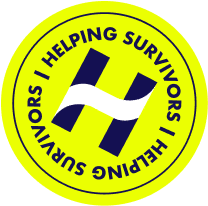What is Sexual Assault?
Sexual assault refers to any non-consensual sexual physical act including unwanted touching, kissing, groping, or penetrative sexual acts. If you or someone you know has experienced sexual assault, learn more about how you can seek help and healing.

Have you experienced sexual assault or abuse?
Helping Survivors can connect you with an attorney if you may have a case. While we cannot report a crime on your behalf, your safety is important. Please contact your local authorities for further assistance.
"*" indicates required fields

Author: Kathryn Kosmides
Survivor Advocate
Home » What Is Sexual Assault?
- Sexual assault encompasses any nonconsensual sexual act or behavior, including forced intercourse, child molestation, fondling/groping, and attempted rape.
- Sexual assault can be perpetrated by anyone, including an acquaintance, family member, current or former romantic partner, or a stranger – with most abuse happening by someone the victim knows.
- Individuals who experience sexual assault often have difficulties initially labeling their experiences and may take years to disclose to anyone. As survivors begin to process the experience, it is important they have support and the information they deserve to help them make informed decisions on what steps they want to take to reclaim their lives and move forward.
What is Sexual Assault?
Sexual assault is any type of sexual contact or behavior that occurs without the explicit consent of the recipient. Sexual activities such as forced intercourse, forcible sodomy, child molestation, incest, fondling, and attempted rape all fall under the definition of sexual assault.
Sexual assault can occur with a stranger, an acquaintance, a family member, or a partner. According to the 2018 National Study on Sexual Harassment and Assault, more than 1 in 4 women (27%) and 1 in 14 men (7%) are survivors of sexual assault or have experienced sexual assault in their lifetime. It can happen to anyone regardless of gender identity, age, income, or sexual orientation.
It’s important to remember that sexual assault is never the victim’s fault. It doesn’t matter if the victim had a previous relationship with the perpetrator, was drinking, or wearing certain clothes—the only person responsible for the assault is the perpetrator.
The Legal Definition of Sexual Assault
Sexual assault occurs when a person is forced or coerced into any nonconsensual sexual act or behavior. This includes situations in which a person is unable to give consent due to age, disability, inebriation, fear, or other circumstances.
The term sexual assault is sometimes used interchangeably with rape. But not all crimes labeled as sexual assault are rape. In fact, rape is just one type of sexual assault covered under federal law—others include unwanted touching and attempting to commit rape.
The legal definition of sexual assault varies somewhat among states. Anyone who sexually assaults another person breaks the law; but the corresponding punishment depends on what exactly they did and in which state the offense took place. In many states, for example, it’s a felony to use force or threats to pressure a person into having sex.
Force doesn’t necessarily refer to physical actions. Perpetrators may use emotional coercion, psychological force, or manipulation to coerce a victim into performing nonconsensual sexual acts. Some perpetrators will use threats to force a victim to comply, such as threatening to hurt the victim or their family. Force can also include financial force (such as when a boss uses their position of power against you) or physical force, which can include strangulation, using foreign objects, or removing your physical abilities such as utilizing handcuffs or utilizing illicit substances to alter your mental capacity.
What is Consent?
Understandably, there’s a lot of confusion about what legally constitutes consent. Generally speaking, consent must be informed (knowing), freely given (voluntarily), and an agreement between participants who have the capacity to agree. Consent must be ongoing and revocable—it may not be inferred from silence, passivity, or lack of resistance, and it cannot be given by someone who is sleeping, overly inebriated, or unconscious.
Consent looks like:
- Sharing a verbal “yes” with your partner
- Partners asking for permission before escalating sexual activity
- Confirming interest before any touching or physical intimacy occurs
- Hearing or giving confirmation that you and your partner are comfortable with sexual activity
- Making it clear to your partner that they are free to stop the sexual activity at any time
Consent does not look like:
- A partner continuing sexual activity after you’ve told them “no”
- A decision influenced by drugs or alcohol
- Assuming a person wants to have sexual contact because of the clothes they are wearing
- Assuming a person wants to have sexual contact when they are sleeping or unresponsive
- Sexual contact with a minor
- Assuming you may continue sexual contact with a person because you’ve been intimate in the past
- Refusing to stop sexual contact after one partner changes their mind and rescinds consent
- What is Sexual Assault?
- The Legal Definition of Sexual Assault
- What is Consent?
- If you are not sure where to turn, RAINN can help.
- What is Considered Sexual Assault?
- What is the Difference Between Sexual Assault and Sexual Harassment?
- Is Sexual Assault the Same as Rape?
- Sexual Assault Statistics
- Who Can Be Victims of Sexual Assault?
- Who Can Be Perpetrators of Sexual Assault?
- How to Get Help After Experiencing Sexual Assault
- Statute of Limitations for Sexual Assault
- How to Help a Victim of Sexual Assault
- Want To Speak With A Lawyer?
Understanding consent can help you protect yourself and those around you.
If you are not sure where to turn, RAINN can help.
Call 800-656-HOPE (4673) to talk confidentially with a trained professional from RAINN.
They can put you in touch with local resources and organizations that can help in your healing journey.
What is Considered Sexual Assault?
As defined by RAINN, some forms of sexual assault include:
- Attempted rape
- Fondling or unwanted sexual touching
- Forcing a victim to perform sexual acts, such as oral sex or penetrating the perpetrator’s body
- Penetration of the victim’s body, also known as rape
Sexual assault can take many different forms and be defined in different ways, but one thing remains the same: it’s never the victim’s fault.
What is the Difference Between Sexual Assault and Sexual Harassment?
Sexual assault and sexual harassment are often used interchangeably. However, they denote two different things.
Sexual Assault
Sexual assault is a form of sexual violence that can involve any type of forced or coerced sexual contact. This can include unwanted touching of a person’s intimate parts, kissing, or fondling. It can also include rape, which is when someone forces a person to have sex against their will.
Sexual Harassment
Sexual harassment is any unwanted behavior of a sexual nature that makes you feel uncomfortable or unsafe. It includes behaviors like stalking, catcalling, sending suggestive texts or photos, and making lewd comments. In some cases, sexual harassment may lead to sexual violence. Oftentimes sexual harassment is thought of only in the workplace setting, but sexual harassment is not
Is Sexual Assault the Same as Rape?
As mentioned above, the terms sexual assault and rape are often used interchangeably. Although their definitions overlap, they are not the same thing.
Rape is a form of sexual assault, but not all sexual assaults are rape.
The term rape is often used as a legal definition to specifically denote sexual penetration without consent. For its Uniform Crime Reports, the FBI defines rape as “Penetration, no matter how slight, of the vagina or anus with any body part or object, or oral penetration by a sex organ of another person, without the consent of the victim.”
There are other forms of sexual assault that do not involve any form of penetration, such as nonconsensual touching of private parts. If you are unclear on how to define what happened to you, we recommend taking Garbo’s “Was I sexually assaulted?” Quiz which has been taken by over 250,000 people and will help you better understand your experience and resources available to you
Sexual Assault Statistics
Sexual assault statistics give us some idea of how widespread the problem is. According to Stop Street Harassment, an estimated 81% of women and 43% of men report experiencing sexual assault or harassment in their lifetime.
Stop Street Harassment also reports that most sexual assaults take place at either the perpetrator of victim’s residence and that victims are more likely to experience sexual violence from someone they know than a stranger.
Recent research by Julie Valentine from BYU also indicates the alarming rate of victims who experience “first date sexual assault”. Her research found 1,968 instances of sexual assault where the perpetrator of the assault was an acquaintance. For about 14% of acquaintance sexual assaults, an assault occurred during the initial in-person meeting after first connecting through a dating app. She also found that in the cases of first date sexual assault, nearly a third of victims reported being strangled – and the researchers concluded that some violent sexual predators use dating apps as a method to find and exploit vulnerable people.
The statistics tell us that sexual assault happens to people of all ages and genders, typically by a familiar acquaintance in a private atmosphere. We also know that only 1 in 5 victims report to the police — which survivors note fear of retaliation, feeling like they won’t be believed, and also wanting to move on with their lives as reasons they do not report. While we understand why victims do not report, we encourage every survivor to do what is best for them.
Who Can Be Victims of Sexual Assault?
Sexual assault can happen to anyone regardless of age, sexual orientation, or gender identity. Of these victims, about 1 in 3 women and 1 in 4 men were sexually assaulted for the first time between the ages of 11 and 17
Men and boys who have been sexually assaulted or abused may have many of the same feelings and reactions as other survivors of sexual assault; but they may also face some additional challenges because of social attitudes and stereotypes about men and masculinity.
Men sometimes believe that they should be able to prevent an assault from happening and blame themselves if they weren’t able to stop it. Some people believe that men should be tough, aggressive, unemotional, and always able to defend themselves against any threat. In reality, no one deserves to be sexually assaulted, regardless of how they dress or act. Men are never responsible for being assaulted.

Who Can Be Perpetrators of Sexual Assault?
Many people believe there are certain personality traits that make someone more likely to commit sexual assault and rape than others, but there is limited research and evidence into perpetrators of harm. Perpetrators of sexual assault come from all different backgrounds, cultures, and races. In fact, most people know their rapists—51.1% of female rape victims reported that their intimate partner was the perpetrator, and 40.8% reported being raped by an acquaintance. This means that over 90% of sexual assaults are committed by someone known to the victim, which could include a partner, a previous partner, someone thought of as a friend, a teacher, employer, coworker, a religious figure, or relative.

How to Get Help After Experiencing Sexual Assault
If you are in immediate danger, call 911. If you are not in immediate danger, you can call the National Sexual Assault Hotline at 800-656-HOPE (4673) to be connected with a local sexual assault service provider. You can also search for a local service provider by visiting centers.rainn.org or chat with an advocate online rather than by phone.
A sexual assault service provider can connect you with a nearby health facility if you wish to seek medical care, including having a Sexual Assault Forensic Exam (SAFE) performed (also known as a “rape kit”). Even if there are no visible injuries, it is highly recommended to see a doctor soon after an assault. Your doctor can provide treatment for any injuries and check for other health problems related to the assault, including testing for sexually transmitted diseases.
You may choose whether to report the sexual assault immediately or at all. Either way, it’s usually best for your physical and mental health to see a doctor or nurse for medical treatment and testing for sexually transmitted diseases (STDs). A medical doctor or facility can not force you to report and can not report on your behalf unless they are required to do so by law – which is usually if children were involved or if you or someone is at risk of serious bodily injury (self harm).
Your doctor can also provide information on local resources that can help you deal with the emotional aspects of a rape or sexual assault. In most cases, a Sexual Assault Forensic Exam must be performed within 72 hours of the assault. A SAFE exam will not only document and collect physical evidence, the medical team will assist in helping you understand your options, including reporting. While it is not required, having an official SAFE medical exam performed will further the likelihood of a criminal prosecution should you choose to report.
After experiencing an assault, you are likely feeling confused, overwhelmed, hurt, and a mix of other emotions. You may want to shower or destroy the clothes you were wearing – but it’s very important that you do not shower or change clothes before going to the hospital or police station. You should also save any text messages, voicemails, and social media posts from the perpetrator. If you are having trouble processing what you should do in your individual scenario, we recommend reaching out to an advocate at a hotline who can help guide you to the best options for your needs.
Statute of Limitations for Sexual Assault
The statute of limitations (SOL) is the period of time after a rape or sexual assault in which you can bring charges against your rapist or attacker.
Each state has its own statute of limitations, and that time period begins on the date of the assault. Once the criminal statute of limitations runs out, criminal charges can no longer be brought for that particular incident.
In some states, the statute of limitations for reporting a rape is as little as three years; in others, it’s as long as 10 years. And in some cases, if DNA evidence is discovered after the statute of limitations has run out, you may be able to reopen your case and file charges against your attacker.
There are also civil statute of limitations for survivors to file a sexual abuse lawsuit and these vary by state. Reach out to Helping Survivors to learn more about the civil statute of limitations and to learn more about filing a sexual abuse lawsuit.
How to Help a Victim of Sexual Assault
If someone you know has been sexually assaulted, you may want to help but not know what to do. Here are important ways to support someone who’s experienced sexual violence or abuse.
The most important thing you can do for someone who has been sexually assaulted is to listen to the person with an open heart. Listen without judgment or interruption, and be prepared for the possibility that they may react with anger or tears.
If someone has disclosed an experience of sexual assault to you, ask them if they would like assistance contacting the police or a medical professional. If they say “yes,” offer to accompany them to the hospital or the police station. If they say “no,” assure them that it is their choice not to report at this time, and you will respect that choice—don’t pressure them into reporting. You can provide support in other ways, including long after they disclose the incident to you, including helping the person with tasks, booking appointments for them, helping them plan some self-care, and simply being a good friend and support system.
Someone who has been sexually assaulted needs support and validation from those around them. Remind them that it is never okay for someone to force another person into sexual activity without consent—this includes emotional manipulation as well as physical force.
They may be afraid of being blamed or neglected by others. Let them know that they have support, that the assault was not their fault, and that they are not alone in their experience. Their healing journey will not be linear and they won’t one day be healed from this experience completely. Every survivor’s journey is their own – and if you are a survivor of any harm, including sexual assault, you know that the most important thing is allowing that space and time to process in their own ways.
And finally, offer professional resources for them to connect with. The National Sexual Assault Hotline at 800-656-HOPE (4673) can provide immense help and useful information on community groups that can provide ongoing support. As a friend or family member of a victim of sexual assault, you can also call a hotline or chat with an advocate to help understand how you can best help the survivor in your life.




Want To Speak With A Lawyer?


